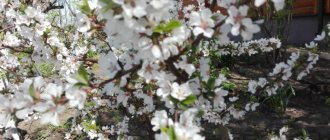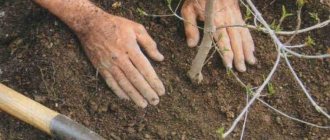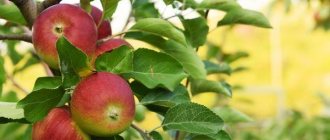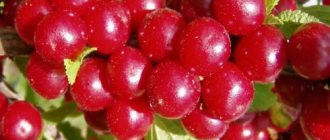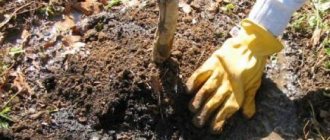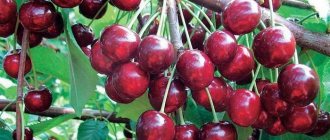When planting heat-loving cherries in the Central region of Russia, the gardener must be confident in its ability to withstand low winter temperatures. Scientists involved in crop breeding primarily try to instill precisely this characteristic in cherry varieties. For example, Octave, created at the end of the last century, has been proving its reliability for many years. It was developed in Bryansk at the State Agricultural Experimental Station (FSC “Vic named after V.R. Williams”). The authors of the new product are A.I. Astakhov and M. V. Kanshina, identified our heroine among the seedlings of cultivated varieties grown in the nursery; the selection was carried out on the basis of marker traits, the formation of which does not depend on environmental factors. In 1982, the new product entered variety testing, and since 1986 it has been listed in the State Register of Breeding Achievements of Russia. Permission for cultivation was obtained in the Central region. The variety is suitable for use in intensive plantings.
Description of cherry Octave
The species is zoned in the Central District. But the description given by the breeders of the Octava cherry variety is one thing, and the reviews of the gardeners who grow it are completely different. According to them, with climate change it has proven itself well in the northwestern regions, as well as in Belarus.
The Octava cherry variety is a medium-sized tree. Their height rarely exceeds two meters. The crown is round, formed by medium-sized skeletal branches and thin shoots at the age of 1-2 years. Healthy young shoots have smooth bark with a slight glossy sheen, predominantly a rich red-brown color. The skeletal branches acquire some roughness and a lighter shade.
The leaves of the Octave cherry are small and elliptical. The leaf blades have finely serrated edges, curl slightly along the central vein, and resemble a boat shape. Their surface is matte, rich green, with yellowish veins.
Octave cherry inflorescences form on thin fruit branches, mainly on peripheral shoots. On the one hand, this simplifies harvesting, on the other hand, it requires some skill when pruning shoots and forming the crown.
The sepals themselves are quite large, cup-shaped. They consist of 6 oval petals of snow-white color, collected around bright yellow elongated anthers and stamens. Flowers are collected in clusters of 3-5 pieces each. According to descriptions and photos of gardeners, the Octave cherry variety resembles a white cloud at the moment of flowering.
The berries of the Octave cherry are medium in size and have a flat-round shape. Their weight is about 4 grams. The color is dark cherry, almost black at the stage of full biological maturity. The fruits themselves are dense, fleshy, quite juicy, with a small stone that is easily separated from the pulp. Octava cherry, according to gardeners, is sweet, with slight notes of light sourness and tartness. The tasting score according to various sources is within 4.3-4.7 points out of five possible ones.
The berries are easily removed from the branch and come off the stalk, remaining dry. At the same time, Octave cherries are not prone to cracking berries or baking them in the sun. No one who has encountered the cultivation of this variety talks about the shedding of ripe berries. This is a very important point for working summer residents.
Cherry Vita variety description photo reviews
An amateur gardener who wisely selects and grows cherry seedlings of different ripening periods in his garden will be able to consume unprocessed fruits for two months. In addition, there are varieties whose fruits may not fall from the tree for several days after ripening, and can also be stored in a cool place for some time.
Scientists and amateurs have developed a significant number of new varieties of cherries. The gardener should grow those varieties that have been tested at experimental stations over a long period of time. Those varieties that are quickly promoted to the market based on the results obtained over the course of one or two years may not correspond to the declared characteristics. The loss of time will amount to several years. You should also not plant root shoots of cherries; special techniques must be used to grow them.
To eliminate mistakes, you need to purchase varieties grafted onto rootstocks that have increased resistance to cold winters.
Characteristics of the variety
Octave cherry has average winter hardiness. It is believed that shoots tolerate severe frosts worst of all. They can be damaged at air temperatures of 12-15 degrees below zero. The root system is more stable. The buds are practically not damaged by frost. Its flowers also do not suffer from drops in spring night temperatures to 1-3 degrees below zero. This gives Octava cherries a great advantage over other varieties cultivated in the middle zone, since return frosts have virtually no effect on yields.
Attention! To prevent shoots from freezing, Octave cherries are planted on the southern sides of high hedges or buildings. Choose places between buildings located from east to west, but in such a way that they do not shade low trees.
The variety is relatively drought-resistant. However, in dry years it requires regular watering. Excess moisture, leading to soaking of the root system, significantly reduces the yield of cherries, often causes diseases and causes the death of the plant.
Pollinator varieties
Octave cherry breeders and gardeners have been arguing for many years about the self-fertility of the variety. The first believe that it does not require planting pollinator varieties nearby. Gardeners are confident that planting varieties such as Lyubskaya or Shokoladnitsa nearby will help increase productivity.
The Octave cherry itself can act as a pollinator for cherries with similar flowering periods. But self-fertile varieties are rarely used in this role. The fact is that pollination takes place inside the bud, and when it opens, not so much sprouted pollen is formed.
Features of fruiting
The Octave cherry begins to bear fruit at 3-4 years of age. Although flower buds are formed a year after planting. However, it is recommended to cut them off to give the tree time to fully take root and gain strength.
It is believed that Octave bears fruit annually and evenly. But many owners of garden plots note wave-like fruiting according to the pattern one year after another. It cannot be said that the tree does not bear fruit after a year. But the yield is slightly reduced. Whether this point is related to the characteristics of the Octave variety or weather conditions is unknown.
Reviews from gardeners about the Octave variety
Octave cherry can grow successfully in southern and middle latitudes. Caring for compact and fairly hardy plants is simple and does not require any special experience. An exceptionally fast-growing variety will very quickly please amateur gardeners with an abundant harvest of marketable fruits. With an intensive cultivation method, the requirements for agricultural technology are increased, but such plantings are usually managed by specialists.
- Author: Zaplavskaya Tamara
I have several professions in different fields, including a musician and an accountant. Higher education. Rate this article: (1 vote, average: 1 out of 5)
Rules for planting Octave cherries
It is advisable to plant Octave cherries in the spring months, but before active sap flow begins. Autumn planting is possible only in the southern regions.
To plant Octave cherries, choose well-lit places, protected from northern and eastern cold winds. More attention is paid to the mechanical composition of the soil, its acidity and the level of groundwater. They prefer light, well-drained sandy or loamy soils with a pH level close to neutral.
Attention! You cannot plant Octave cherries in low places where moisture can accumulate during rains or melting snow. If groundwater is close, arrange good drainage or plant the seedling on a natural or artificial hill.
- For planting, prepare a hole about 50-70 cm deep and approximately the same diameter.
- A drainage layer of coarse crushed stone or pebbles is arranged at the bottom.
- The soil is mixed with compost, peat, humus. Add wood ash and potash-phosphorus fertilizers.
- A nutrient layer is arranged, and an Octave cherry seedling is planted on it.
The holes are closed, the soil is thoroughly compacted so that there is no air between the roots, and watered abundantly.
Cherry Octave v7 100-120 Tim
Availability of goods in hypermarkets:
- Darwin Solnechnogorsk - 29 pcs.
- Darwin Podolsk - 17 pcs.
- Darwin Zelenograd - 12 pcs.
- Darwin Pushkino - 18 pcs.
- FAVORABLE DELIVERY
We will quickly, efficiently and inexpensively deliver your purchase to your location. - PAYMENT METHODS
More than 10 ways to pay for your purchase, both online and in the hands of the courier. - GARDENER SERVICES
Entrust the care of your garden to a professional gardener from the garden. - OWN PRODUCTION
Peat, fertilizers, soil of our own brands at excellent prices! - OWN NURSERY
We grow more than 1000 species of plants in our own nursery.
Octave cherry care
During the growing season, the Octave cherry needs:
- In early spring pruning. At this time, frozen shoots and branches growing inside the crown are removed. In the first 3-4 years, the plant also requires formative pruning. The result should be a crown on a low trunk, with 10-12 multidirectional skeletal shoots at a distance of 10-15 cm from each other.
- Watering is carried out in dry years. In normal years, cherries are watered as needed during flowering and fruit set. And also after the end of fruiting, when the buds are laid for the next year.
- In fertilizing with organic and mineral fertilizers. But if it is advisable to add mineral compounds annually, during the period of berry growth, then organic matter should be used once every 2-3 years. An exception is made for Octave cherries, which grow in regions with relatively cold winters, when the soil is mulched with compost for the winter.
- The root circle must be weeded and loosened. Mulching with sawdust will retain moisture at the roots and slow down the growth of weeds.
Description of the Ognevushka variety cherry and its characteristics, advantages and disadvantages
Not only residents of the southern regions of Russia love cherries, but also northerners. Northern varieties differ from their counterparts in their high resistance to extremely low temperatures; such trees are strong, early ripening, and hardy. Our cherries belong exactly to this category. Description of the Ognevushka cherry variety will not take much time. The characteristics of this variety of cherries speak for themselves, and all you need to do is choose the bright Ognevushka.
Description
The most important advantage when describing the Ognevushka cherry variety is its ability to withstand frost. In this case, it is -50 degrees, which is a very impressive factor. Harvest most often occurs at the end of July. The fruits are small but juicy, with a pleasant sourness and a sweet aftertaste. The variety is highly self-fertile, flowering lasts for a long time.
Advantages and disadvantages of the variety
When choosing a cherry variety to plant in a region with low temperatures, use the pros and cons categories. The advantages of the Ognevushka variety are:
- high frost resistance (withstands frosts down to -50 degrees);
- juicy, tasty, sweet and sour fruits;
- early maturation.
The disadvantages include the following:
- fruiting begins only 4 years after planting;
- the need for painstaking care - the formation of a bush, safety from strong winds;
- small fruit weight.
Characteristics of the tree and fruits
The crown of the tree is round, with a wide girth. The height reaches 1.8 meters. Flowering is long lasting and bears fruit every year. The variety belongs to the highly self-fertile category. The average weight of the fruit is 3 grams, round in shape. The color of the peel is bright red, the flesh is a couple of shades lighter. The latter is juicy, with a pleasant sweet taste with sourness.
Features of cultivation
Siberia is a region with one of the harshest climates. Because of this, the crops grown there bear fruit abundantly, ripen quickly and withstand extremely low temperatures. This result will be a reward only for those who create acceptable conditions for the development of the plant.
Planting should be done on a hill where the area is not hidden from sunlight. It is advisable to provide the planting with protection from the wind. This will be facilitated by a wall, fence or building nearby. The tree should be planted in the spring, starting in April, when the snow and ice have melted from the soil.
The specificity of Siberian cherry varieties is that they form in the form of bushes. The fruits grow on thin annual branches, therefore, the more of them that grow, the richer the harvest, and vice versa. The growth of young branches is promoted by timely pruning. Make sure that there are no more than 15 branches per bush with wide side branches. Remove dead wood, damaged, old (more than 8 years old) or diseased branches. Every year it will be enough to leave a couple of root branches.
Important! During intensive growth, be sure to feed and water the plant
Diseases and pests
The Michurinskaya cherry variety is highly resistant to many fungal diseases. The most common diseases that are characteristic of this variety:
Among the pests, the cherry weevil is the most dangerous.
Monilial burn
This disease is characterized by drying of leaves, young shoots and ovaries.
To combat the disease, preparations based on copper or sulfur are used. You can spray trees with Zircon. Damaged parts of the cherry tree should be trimmed and burned.
Coccomycosis
This disease begins with the appearance of small spots on the leaves of the tree. They have a bright red color. Gradually they merge into large spots.
On the reverse side, spores of pathogenic fungi are located in grayish pads. These leaves curl and fall off.
The fight against this disease begins with its prevention. In autumn and spring, it is necessary to carefully dig up the soil in the tree trunk circle. All fallen leaves are removed from under the tree and burned.
Treatment of coccomycosis involves treating cherry trees with copper-based fungicides and Bordeaux mixture.
Cherry weevil
The pest insect climbs into the cherry fruit and lays its larvae there. Their development leads to deformation of the berries and loss of the entire harvest.
To combat the invasion of these pests, the tree is sprayed with insecticides twice during the entire summer season. The first treatment is carried out at the moment of bud break. The second spraying must be carried out during flowering.
As a preventive measure, dig up the soil in the tree trunk circle.


